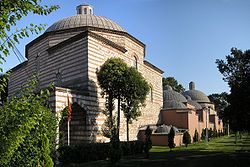Hammam
Hammam is a Turkish steam bath and also a public bath.[1] This is common in the Middle East. Hammam is not used just to be clean. Hammam is also about spiritual purity or ablution.
History
Bathhouses were found throughout the Mediterranean world. They were used to the mid-6th century in the early Byzantine Empire.[2]
In Europe hammam was also popular, especially in Victorian era.
Hammam Media
Remains of the Antonine Baths in ancient Carthage, from the Roman period, in present-day Tunisia
Qusayr 'Amra in Jordan, among the earliest known examples of Islamic bathhouses, dating from the Umayyad period (7th–8th century)
The "Tree of Life" mosaic in a reception room of the bathhouse at Khirbat al-Majfar, a 7th or 8th century Umayyad-era archeological site in the West Bank
Haseki Hürrem Sultan Bathhouse in Istanbul, Turkey, commissioned by Roxelana and designed by Mimar Sinan (16th century)
16th-century Sultan Amir Ahmad Bathhouse in Kashan, Iran. Part of it is now used as a teahouse.
Hammam interior, showing water buckets and tilted floor (Baños del Almirante, Valencia)
A Peshtemal, hammam towel
Vaulted chambers of the Umayyad bathhouse at Qusayr 'Amra, covered in Late Roman or Byzantine-style frescoes (7th or 8th century)
References
- ↑ Suemedha Sood (November 29, 2012). The origins of bathhouse culture around the world. BBC Travel. https://www.bbc.com/travel/article/20121129-the-origins-of-bathhouse-culture-around-the-world. Retrieved July 8, 2021.
- ↑ Zytka, Michal (2019-03-28). A Cultural History of Bathing in Late Antiquity and Early Byzantium. Routledge. ISBN 978-1-351-13409-5.









